How To Create Engaging Quizzes That Grow Your Audience

Do you struggle with getting your audience to engage with your content and calls to action on your site? Are you interested in using quizzes to increase engagement but aren’t quite sure of which quiz types to use?
In this post, we cover six quiz types effective at getting your audience to interact with your content. We’ll also show you one of the easiest ways to create quizzes for your site.
First, let’s discuss the benefits quizzes can provide for your blog as a whole.
Note: Want our latest content delivered to your inbox? Click here to subscribe to the free Blogging Wizard newsletter.
Why should you create online quizzes for your audience?
Your readers spend most of their time on your site reading content, clicking links and filling out forms. However, the probability of them interacting with your site is dependent on how alluring your calls to action are.
Quizzes provide much more effective ways for you to encourage readers to interact with your site. They’re more engaging because of that interactive nature, so they’re more likely to help you achieve your marketing goals.
You’ll start to notice two benefits as a direct result of that engagement over time, namely in the amount of email leads and social media follows you receive.
First, many online quiz makers were designed with lead generation in mind. This means you’ll be able to insert an opt-in form on the results page. Some quiz makers even allow you to insert that form just before the results display in a way in which your reader must subscribe to your email list in order to see their results.
You can do the same with social media. Along with simply encouraging quiz takers to share your quiz, you can increase your social media presence by barring results until your reader shares the quiz.
Furthermore, you can create badges and generated messages readers can use to share their results across multiple social media platforms.
Over time, this increase in engagement will lead to an increase in the amount of conversions and traffic your site receives. All it takes is a keen quiz maker and the right quiz type(s) for your audience.
6 types of quizzes to create for your audience + examples
There are dozens upon dozens of quiz types we could share with you, but we’re going to narrow that list down to six of the best options to use for a blog audience no matter what your niche is.
Here’s a quick overview of each one:
- Personality quiz – An easy way to provide your reader an assessment based on the way they respond to a certain number of questions.
- Scored quiz – A graded quiz in which your reader receives a percentage or X-out-of-Y score based on the number of questions they answer correctly.
- Trivia quiz – Similar to the score-based quiz, only this one uses true/false-based questions.
- Guided quiz – Help your reader make a decision by changing the questions they’re asked based on their answers to previous questions.
- Guided quiz for products – Same as the guided quiz, except this one markets your products.
- Generator – An extremely interactive quiz that generates an idea or suggestion for your reader in the results, such as a song topic.
Let’s expand on each one.
Tried and true personality quizzes
Personality tests come in many different forms. In the world of psychology, a personality test is used to assess individuals based on key parameters surrounding social, learning and psychological areas of interest.
The most popular example of this type of personality test is the 90-question professional assessment offered by The Myers & Briggs Foundation. Participants are assigned one of 16 personality types upon answering a series of questions based on the aforementioned areas of interest.
Even more popular forms of this quiz type can be found at BuzzFeed.
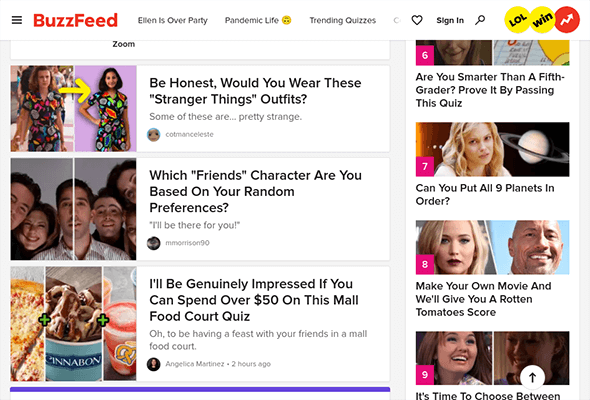
They’re fun quizzes whose questions all relate to a central topic. Take the “Which Friends Character are You Based on Your Random Preferences?” quiz as an example.
Each question asks about a specific preference for food, the type of movies you most enjoy, your favorite color, etc. There are six answers per question for each of the six characters of the TV series Friends, and each answer has been assigned to one particular character.
Participants are assigned one of six characters at the end of the quiz based on how they answered each question. If the majority of their answers fall under the Ross category, they’re assigned Ross. If the majority of their answers fall under the Phoebe category, they’re assigned Phoebe.
Using personality quizzes
Your goal now is to use these examples to come up with your own personality quiz (or several) designed specifically for your audience.
We can see from these two examples that there are two ways you can approach this type of quiz.
When you use the Myers & Briggs approach, you’ll create an informative, psychological quiz intended to identify your reader with a particular personality type relevant to your niche. The result they’re given will help them reach a particular goal or lead them to a particular solution.
Take this written quiz published to Medium as an example of how to create a personality quiz for your niche. It tells you what type of writer you are and provides advice on how to wield or overcome the strengths and weaknesses attributed to your writing type as you approach your next project.
With the BuzzFeed approach, you’ll come up with a fun personality quiz akin to the type of “which X are you” quizzes you’ll find on the site. Here’s a great example from music magazine Making Music.

It’s an interactive quiz that reveals which classical pianist you are most like based on preferences for a variety of different things not necessarily related to music.
Consider your audience, and come up with a few ideas for both personality quiz types.
Score-based quizzes
Score-based quizzes are self-explanatory, but let’s go over a few different ways you can use them.
First, you can use it in the same way school and online courses use them—as a way for you and your reader to assess their knowledge about a particular subject in your niche.
Second, you can treat it as a fun trivia quiz and test your reader’s knowledge about a subject that’s irrelevant to their overall knowledge and understanding of your niche, such as “how well do you know classic guitar solos” as opposed to “how many guitar chords can you play by memory.”
Lastly, you can use this type of quiz to assess how well a potential customer has a handle on a particular situation.

An example of this is the simple quiz offered by SpiderGroup that lets participants know how secure their businesses are by producing score-based results.
True/false trivia quizzes
These types of quizzes are highly similar to score-based quizzes, except your questions will revolve around true-or-false answers. As such, every quiz you create should either assess your reader’s knowledge about a particular topic or give them a fun way to answer a series of trivia questions.

Here’s a simple example by Carpology. It’s a 15-minute quiz in which every question has true and false options but only one is correct.
Decision-making quizzes
Many quiz makers have what’s known as “conditional logic.” It’s a type of quiz layout that changes the questions participants are asked based on how they answer previous questions.
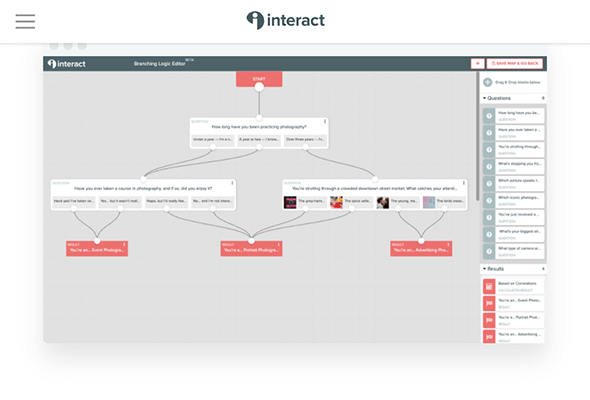
Let’s say you have a finance blog and want to design a quiz that helps your reader decide whether or not they’re ready to buy a home. One of your questions could be, “have you set aside money for a down payment?”
If your reader answers no, you could direct them to a follow-up question that asks, “do you think you’ll have enough money set aside for a down payment within the next year?”
If your reader answers yes to the former question, you could instead ask them how much they’ve saved up.
The biggest benefit of creating a quiz that helps your reader make a decision is the way it allows you to tailor your marketing message and call to action to suit their individual needs.
Our example quiz has two possible outcomes depending on whether or not your reader is ready to buy a house. If your reader is ready, you could market your consultation services via an opt-in form.
If your reader is not ready, you could use a different opt-in form to market a guide that will teach them how to get their finances in order well enough to be able to buy a home.
A decision-making quiz is a great way to guide readers to a specific choice or goal. It’s like a mini consultation they can conduct themselves.
One quiz to market multiple products
If you have two products or more that relate to one another, you can also use the decision maker to help customers decide between them.
By identifying the different needs and preferences of your customer base and assigning each to a particular product, you can easily construct a quiz that guides customers toward the product most suitable for them.
A great example of this is Function of Beauty’s Build Your Formula quiz:

It’s a simple, four-question quiz that allows the company to determine which hair-care ingredients would work best for your hair type.
It gives Function of Beauty an edge over their top competitors as few other beauty brands offer the same level of personalization to their customers.
Creative generator quizzes
A quiz that acts as a generator is similar to a personality quiz, only it’s a little more complicated to set up. With a personality quiz, you come up with a specific number of personality types for a particular subject, then come up with questions in which each option is assigned one personality type.
Generator quizzes work in the same way. You come up with generated content for a particular project type, then create questions that assign each option to one of the generated results you created.
The results your participants receive work in the same way results work for personality quizzes. They’re assigned whichever generated content aligns with the majority of their answers or the one your conditional logic tree leads them to.
Let’s look at this song topic generator by Your Creative Aura as an example:
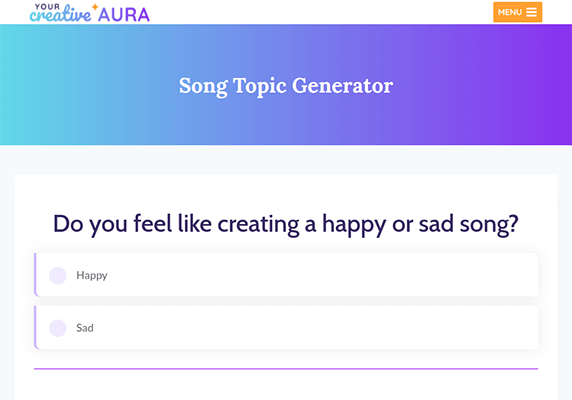
This quiz was created with the WordPress plugin Thrive Quiz Builder.
It guides you through a decision of the type of song you may want to create. At the end of the quiz, you’re given an emotion and story to work with along with scales, chord progressions and tempos to use.
It’s a prime example of the kind of fun and interactive experiences quizzes can add to your site.
Creating engaging quizzes the easy way with TryInteract
Thrive Quiz Builder is a powerful quiz maker, but it requires WordPress and a subscription to Thrive Themes’ membership program. If this an issue for you, use TryInteract instead.

Interact is an online quiz maker that allows you to create beautiful quizzes for a variety of different quiz types and embed them on any website. It comes with a 14-day free trial you can use to try out all of the examples we provided today. Pricing starts at $39/month, or $27/month if paid annually.
This quiz maker expedites the process of creating quizzes by providing templates for you to start with.
Templates are organized by the goal you’re trying to reach. These include lead generation, audience research, fun (highest amount of engagement), audience segmentation and more. You can arrange templates by quiz type as well, specifically personality, score and assessment.
You can also start from scratch if you wish.
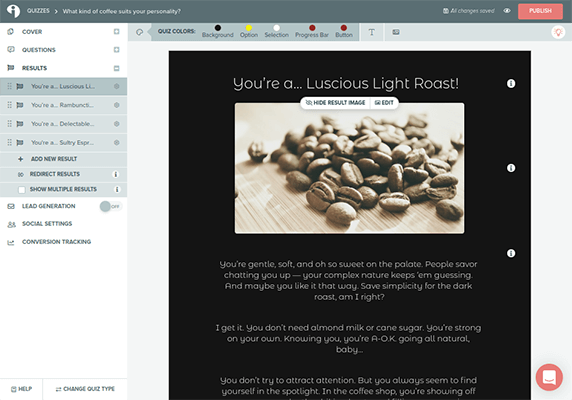
Start by creating your results. With Interact, you can design an entire landing page for each result. The styles you select here will also be applied to subsequent results as well as your questions, so you won’t need to adjust them twice.
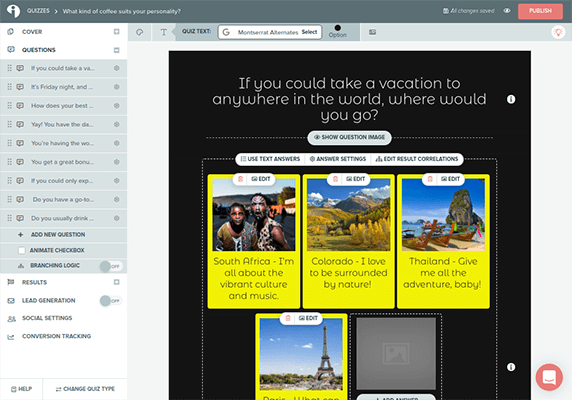
Next, create your questions. Image and text-based questions are available. Because you created your results first, you’ll be able to use Interact’s simple correlation tool to assign each option to a specific result.
Alternatively, enable the Branching Logic option to use the conditional logic tree that guides participants to a particular result.
If you already have questions, you’ll find them in the sidebar where you can drag and drop them wherever you need.
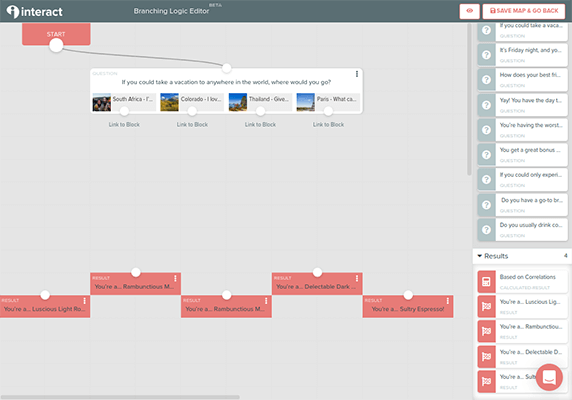
Once you’re done creating your quiz, create a cover page, and configure the lead generation and social media settings. These settings will define the goal you achieve with your quiz.
If you have a higher-tiered plan, you can also enable Facebook Pixel and Google Analytics for conversion tracking.
After you publish and embed your quiz, you’ll be able to view reports and analytics that showcase how many views and completions your quiz has received, which results are most popular, and more.
It’s a fun way to engage your audience while also learning more about them and their individual needs.
Final thoughts
Running an online quiz is no easy feat. It requires a keen understanding of your audience, particularly the individuals within your audience as well as their specific needs and preferences.
You can learn this information by researching your audience’s pain points and asking them to fill out surveys.
Once you know more about them, you’ll be able to create quizzes all but guaranteed to get them to engage with your site. You’ll have more leads, likes and followers on social media along with a boost in traffic as a result.
Once again, we highly recommend Thrive Quiz Builder for easy quiz building in WordPress and TryInteract for quiz building in and outside of WordPress.
Disclosure: Our content is reader-supported. If you click on certain links we may make a commission.
